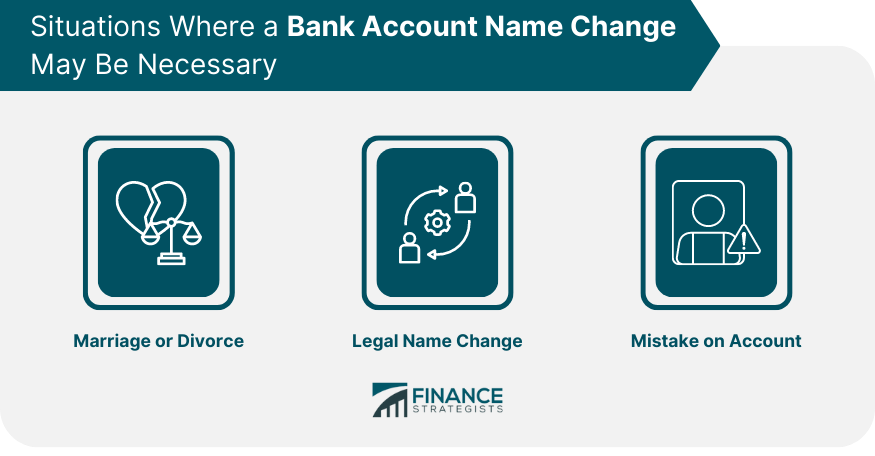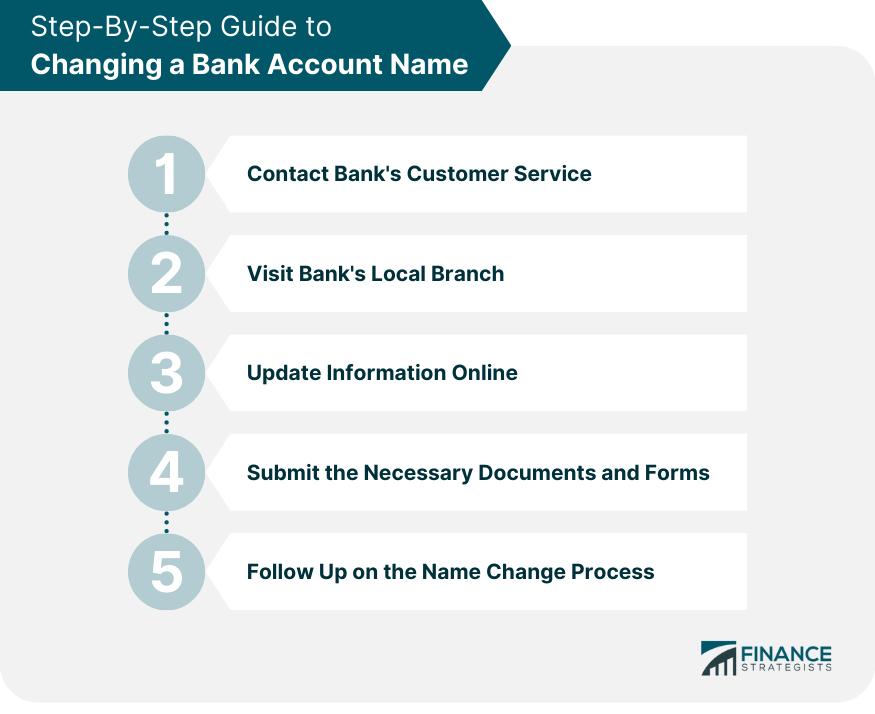Banking is a crucial aspect of the global financial system, providing a variety of essential services. Banks hold deposits, facilitate transactions, extend credit, and manage risks. These services enable economic activity, supporting everything from daily purchases to long-term investments. A bank account is a financial account maintained by a bank for a customer. Types of accounts include checking, savings, money market, and certificate of deposit (CD) accounts. Customers deposit money into these accounts, providing the bank with funds it can lend to others. In return, most accounts accrue interest, growing the account balance over time. Additionally, banks provide account holders with convenient ways to access and manage their money, such as debit cards, online banking, and mobile apps. The regulation and insurance of bank accounts promote trust and stability in the banking system. The most common reason people need to change their bank account name is due to a change in marital status. If you've recently married and taken your spouse's surname, or if you've gotten divorced and wish to revert to your maiden name, you'll need to update your bank account accordingly. If you've legally changed your name, for any number of reasons, you'll need to change the name on your bank account to match. This might occur in cases of gender transition, or if you've changed your name to suit your personal preference. It's possible that there's an error on your bank account when you first set it up. If your name is misspelled or otherwise incorrect on your account, you'll definitely want to get that fixed. Remember, the name on your bank account is more than just a label—it's a key piece of information that your bank uses to identify you. If it's incorrect or out of date, it can lead to confusion and potential issues with your banking services. Understanding what's required to change your bank account name is the first step towards making it happen. It can vary somewhat depending on your financial institution, but typically you will need some combination of the following documents: Proof of the name change (e.g., marriage certificate, court order) Identification that shows your old name (e.g., passport, driver's license) Identification that shows your new name (e.g., updated passport, driver's license) These documents are needed to verify your identity and the legitimacy of your name change. The first step in changing your bank account name is to reach out to your bank's customer service. They will guide you through the process and let you know exactly what information and documentation they require. It's advisable to make a note of the time of your call, the name of the representative you spoke with, and the advice you received for future reference. In some cases, you might be asked to visit your local branch to change your bank account name. Be sure to bring all the necessary documents. You will probably be asked to fill out a name change form and submit your documents. These documents will be reviewed, and you may need to provide additional information. Some banks allow you to update your information online. If this is an option for you, log into your online banking profile and find the appropriate section to update your personal information. Keep in mind that you may still need to provide copies of your name change documents, either by scanning and uploading them or by mailing them in. Regardless of how you interact with your bank, you'll likely need to fill out a form and submit it along with copies of your documents. Always keep copies of everything you submit for your records. After submitting your form and documents, you should follow up with your bank after a week or so to make sure they received everything and that the name change process is underway. Depending on your bank, it can take several weeks for the name change to be processed completely. While most name changes are processed within a few weeks, sometimes there can be delays. If your name change is taking longer than expected, contact your bank to check on the status. They may need additional documentation or there may have been an issue with your paperwork. Once your name has been changed with your bank, you'll also need to update your checks, credit and debit cards, and any electronic payments that are linked to your bank account. Contact your bank to request new checks and cards, and update any electronic payments yourself as soon as your name change has been processed. Don't forget about direct deposits, automatic payments, and your online banking profile. If you have direct deposits coming into your account, you'll need to notify the payer of your new name. The same goes for automatic payments – you'll need to update your information with the payee. And, finally, don't forget to update your name on your online banking profile. Changing one's bank account name is a process that may seem daunting, but it can be streamlined when equipped with the right knowledge. There are several situations where a name change becomes necessary, including marriage, divorce, legal name alterations, or simple account errors. Essential to this process is having the correct documentation in hand, such as proof of name change and relevant identifications. The procedure typically involves contacting your bank's customer service, possibly visiting a local branch, updating details online, submitting necessary documents, and following up to ensure completion. While most banks process name changes within weeks, delays can occur. After updating your name, remember to refresh related items like checks, cards, and electronic payments. Furthermore, updating direct deposits, automatic payments, and online banking profiles is essential to prevent disruptions. With proper diligence, this transition can be smooth and hassle-free. Overview of Bank Accounts
Situations Where a Bank Account Name Change May Be Necessary
Marriage or Divorce
Legal Name Change
Mistake on Account

Documents Required When Changing the Bank Account Name
Step-By-Step Guide to Changing a Bank Account Name
Contact Bank's Customer Service
Visit Bank's Local Branch
Update Information Online
Submit the Necessary Documents and Forms
Follow Up on the Name Change Process

Potential Challenges When Changing a Bank Account Name
Delays in the Name Change Process
Potential Issues With Checks, Credit/Debit Cards, and Electronic Payments
Possible Problems With Direct Deposits, Automatic Payments, and Online Banking Profiles
Bottom Line
How to Change Your Bank Account Name FAQs
You'll typically need proof of your name change such as a marriage certificate, court order, or updated ID showing your new name.
Some banks do allow online name changes. However, you may still need to provide physical copies of relevant documents for verification.
The time it takes can vary by bank, but most changes are processed within a few weeks.
You might encounter delays in the process, issues with updating checks, cards, electronic payments, or problems with direct deposits and automatic payments.
After the name change, update your checks and cards, notify any organizations that deposit to or withdraw from your account, and update your name elsewhere as needed.
True Tamplin is a published author, public speaker, CEO of UpDigital, and founder of Finance Strategists.
True is a Certified Educator in Personal Finance (CEPF®), author of The Handy Financial Ratios Guide, a member of the Society for Advancing Business Editing and Writing, contributes to his financial education site, Finance Strategists, and has spoken to various financial communities such as the CFA Institute, as well as university students like his Alma mater, Biola University, where he received a bachelor of science in business and data analytics.
To learn more about True, visit his personal website or view his author profiles on Amazon, Nasdaq and Forbes.















